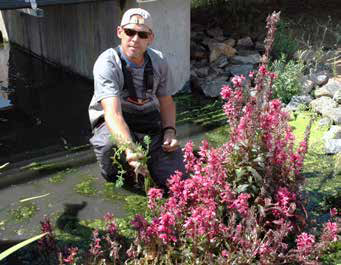“Lakespert” – It’s Not the Plant’s Fault

Three invasives piggy-backing their way into a new treatment pond system just for a pretty photo shoot. The choices we make can have major consequences down the road.
Steve Lundt, CLM
When it comes to aquatic invasive species (AIS), I think we focus too much on the individual species, the actual infestation, and damage control, and not enough on the root cause – people making decisions. People’s actions, most of the time accidentally, lead to moving these species where they don’t belong. I constantly remind myself that it is not the species’ fault. The Brazilian elodea did not decide to travel up from South America. The common carp didn’t swim to the U.S. in the 1830s. The sticky zebra mussel was doing just fine in the Caspian Sea. People’s decisions and actions moved these species, and now we have words like invasive, non-native, nuisance, introduced, and invaders to help explain what we have done wrong.
Here is a great example. A series of three one-acre treatment ponds were constructed to polish wastewater effluent before being released into a river. Just before the grand opening of the facility, administrative staff decided to heavily, and I mean heavily, plant decorative aquatic plants in and around the treatment ponds for opening-day photos (Figure 1). Six months later, I discover three AIS plants, parrotfeather, Eurasian watermilfoil, and Brazilian elodea (first discovery for Colorado), growing in the ponds (Figure 2a-c). At least three of the 250+ aquatic plant pots that a landscaping contractor installed had hitchhikers. Each species was found growing out of a pot. Poorly managed aquascaping practices and administrative decisions clearly created this AIS problem.
The last five years have been spent on eradication efforts ($85,000 on herbicides and at least another $50,000 on staff time), monitoring, and being frustrated with these plants. About 90 percent of the effort has been focused on the species and reactionary efforts. Little effort has been spent on figuring out how people created this problem, and how we can prevent this from reoccurring. We did raid the landscaping nursery but found no evidence of AIS or wrongdoing. The aquatic plant and aquascaping industry need to make better decisions on how aquatic plants are cultivated, transported, sold, and installed in our waterbodies. Administrative staff need to be aware of the unintended consequences and need to include water quality-oriented experts when making water-related decisions – even for a photo shoot.
An ounce of prevention is worth a pound of cure. Let’s make better decisions up front to avoid AIS problems and stop blaming the species.

Invasive plants found in the ponds include (a) hydrilla; (b) parrotfeather; and (c) Brazilian elodea.
 Steve Lundt, Certified Lake Manager, has monitored and worked to improve water quality at Barr Lake (Denver, Colorado) for the past 19 years. Steve is active with the Colorado Lake & Reservoir Management Association and is a past Region 8 director for NALMS and an active member since 1998.
Steve Lundt, Certified Lake Manager, has monitored and worked to improve water quality at Barr Lake (Denver, Colorado) for the past 19 years. Steve is active with the Colorado Lake & Reservoir Management Association and is a past Region 8 director for NALMS and an active member since 1998.

